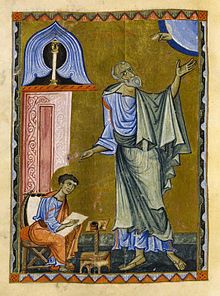Lviv Gospels

The Lviv Gospel Book is a medieval Armenian illuminated manuscript from the 12th century . The gospel book was created in Skevra Monastery . Today it is kept in the Biblioteka Narodowa, the Polish National Library in Warsaw.
description
The manuscript was written in the Armenian language and comprises 446 sheets of size 290 × 220 mm. It was compiled by a monk named Gregor (Grigor Skevratsi) for the Skevra monastery near Lambron , Cilicia in Armenian. The miniatures are typical of the style of the Armenian Cilician illumination of that time. It is dated by the scribe and illuminator Gregor to the year 647 of the Armenian calendar , which corresponds to the period from January 31, 1198 to January 30, 1199.
It was kept in the treasury of the Armenian Cathedral in Lviv for centuries until 1945 , which is why it is called the Lviv Gospels . After 1945 it was secretly brought to Krakow and kept in the Bedenictine Abbey of Tyniec . In the 1980s, Primate of Poland Józef Glemp gave it to the Archbishop's Archives in Gniezno .
Günter Prinzing , Professor of Byzantine Studies at the History Department of the University of Mainz , was able to identify the missing Gospels in 1993. After being preserved in the Gutenberg Museum Mainz, the manuscript was returned to Poland.
Web links
literature
- Günter Prinzing / Andrea Schmidt (eds.), The Lemberger Evangeliar. An Armenian illuminated manuscript . Wiesbaden 1997 (Languages and Cultures of the Christian East 2)
Individual evidence
- ↑ Andrea Schmidt: L'Évangile de Lemberg: un itinéraire rocambolesque , In: Claude Mutafian: Arménie, la magie de l'écrit , Somogy, Paris, 2007 ISBN 978-2-7572-0057-5 , p. 260